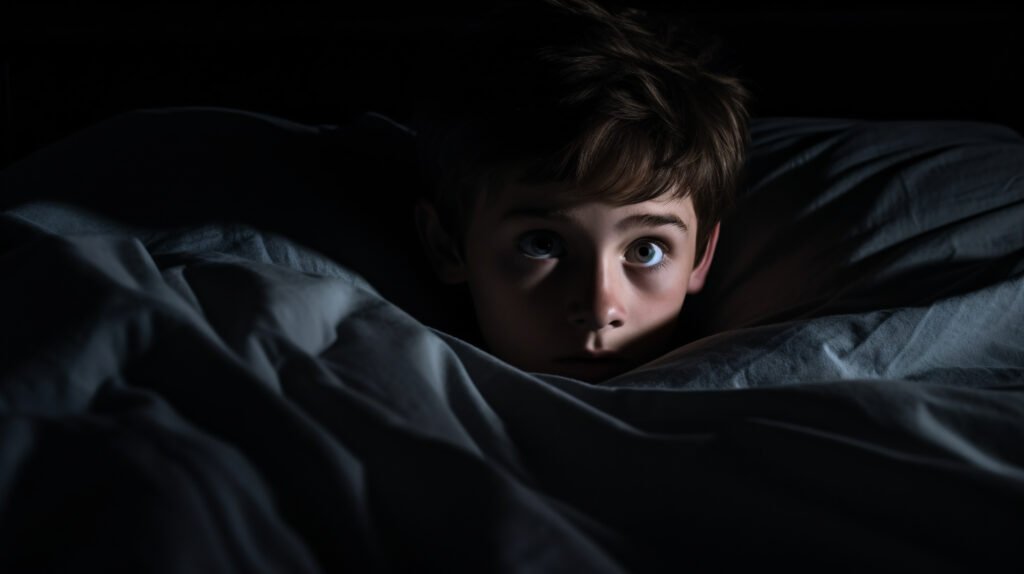If you’ve ever experienced your child waking up in the middle of the night screaming, sweating, and seemingly inconsolable, you might have encountered night terrors. For many parents, these episodes can be incredibly alarming and distressing. Understanding what causes these night disruptions and how to prevent them can be a huge relief and make those sleepless nights easier to manage.
What Are Night Terrors?
Night terrors, also known as sleep terrors, are episodes of intense fear that occur during sleep, typically within the first few hours after falling asleep. Unlike nightmares, which occur during REM (Rapid Eye Movement) sleep and often wake the child up, night terrors happen during non-REM sleep, particularly in the transition between deep and lighter sleep. During these episodes, a child might suddenly sit up in bed, scream, cry, thrash around, and appear very frightened, yet remain asleep throughout the ordeal.
One of the most perplexing aspects of night terrors is that the child isn’t aware of what’s happening and usually has no memory of the event the next morning. While it can be a terrifying experience for parents to witness, night terrors typically don’t harm the child and are usually outgrown by the time your children are grown.
Understanding the Causes
While the exact causes of night terrors aren’t fully understood, several factors are believed to contribute to these episodes.
1. Overstimulation and Stress
Children’s brains are incredibly active, and overstimulated—whether from a busy day, excitement, anxiety, or stress—this can impact their sleep. Overstimulation before bedtime, such as too much screen time or engaging in highly stimulating activities, can prevent a child from winding down properly, leading to restless sleep and possibly triggering night terrors.
2. Sleep Deprivation
Lack of sufficient sleep is one of the most common triggers for night terrors. When a child is overly tired, the body’s normal sleep patterns can be disrupted. This disruption increases the likelihood of sleep terrors as the child transitions from deep to lighter sleep. Ensuring your child gets enough rest can be crucial in reducing these episodes.
3. Genetics
There’s a genetic component to night terrors. If you or your partner experienced them as a child, your child might be more likely to experience them. While genetics isn’t something that can be controlled, understanding this link can help you prepare and manage your child’s sleep more effectively.
4. Fever or Illness
Sometimes, night terrors can be triggered by physical factors such as fever or illness. When a child’s body fights an infection, their sleep can become more disrupted, increasing the chances of night terrors.
5. Sleep Apnea and Other Sleep Disorders
In some cases, underlying sleep disorders such as sleep apnea can contribute to night terrors. Sleep apnea causes interruptions in breathing during sleep, which can disturb normal sleep patterns and trigger episodes. If you suspect that a sleep disorder might be contributing to your child’s night terrors, it’s important to consult with a healthcare professional for proper diagnosis and treatment.
How to Prevent Night Terrors
While night terrors can be unsettling, several strategies can help prevent or reduce the frequency of these episodes.
1. Establish a Calm Bedtime Routine
Creating a consistent, calming bedtime routine can help your child wind down and prepare for a restful night’s sleep. This routine might include reading a book, taking a warm bath, or practicing relaxation techniques such as deep breathing or gentle stretching. The goal is to create an environment that promotes relaxation and helps your child transition smoothly from wakefulness to sleep.
Keeping the routine consistent each night can signal to your child’s body that it’s time to sleep, reducing the likelihood of overstimulation and sleep disturbances. Avoiding stimulating activities like watching TV or playing video games in the hour leading up to bedtime is also important, as these activities can make it harder for your child to settle down.
2. Ensure Your Child Gets Enough Sleep
Making sure your child gets enough sleep is key to preventing night terrors. A well-rested child is less likely to experience disrupted sleep patterns that can lead to sleep terrors. Establish a regular sleep schedule that ensures your child goes to bed timely each day, even on weekends.
If your child struggles with sleep or consistently wakes up tired, it might be worth assessing their sleep environment. Is the room quiet, dark, and comfortable? Are there any distractions that could be interfering with their sleep? Sometimes small adjustments, like blackout curtains or a white noise machine, can make a big difference in your child’s sleep.
3. Manage Stress and Anxiety
Children, like adults, can experience stress and anxiety, which can negatively impact their sleep, if your child goes through a stressful time, whether due to changes at school, social pressures, or family issues, it’s important to address these concerns.
Encourage open communication with your child so they feel comfortable expressing their worries. Sometimes, simply talking about what’s on their mind can help reduce anxiety and make it easier for them to sleep peacefully. Additionally, incorporating relaxation techniques like meditation or guided imagery before bed can help your child release stress and ease into sleep.
4. Minimize Nighttime Disruptions
Night terrors can sometimes be triggered by external factors such as noise, light, or even a full bladder. Minimizing these disruptions can help create a more peaceful sleep environment. Make sure your child’s room is as quiet and dark as possible, and consider using a nightlight if they’re afraid of the dark.
Encouraging your child to use the bathroom before bed can also help prevent them from waking up due to the need to urinate, which can disrupt their sleep and potentially trigger night terror. If your child is sensitive to noise, using earplugs or a white noise machine might help create a more consistent sleep environment.
5. Gradually Wake Your Child
In some cases, night terrors occur at the same time each night. If this pattern is predictable, one strategy to prevent them is to gently wake the child about 15-30 minutes before the usual time of the night terror. Waking them enough to slightly disrupt their sleep cycle without fully waking them up can help reset their sleep pattern, potentially preventing the night terror from occurring.
This technique, known as scheduled waking, should be done gently and carefully. Over time, it can help alter the sleep cycle enough to reduce or eliminate night terrors.
By establishing a calming bedtime routine, ensuring your child gets enough rest, managing stress, minimizing nighttime disruptions, and considering scheduled waking if necessary, you can create a safer and more peaceful sleep experience for your child. Remember, every child is different, and what works for one may not work for another. If night terrors persist or become more frequent, consulting a healthcare professional can provide additional guidance and support. With the right strategies, you can help your child overcome night terrors and enjoy a restful sleep.










Techno rozen Pretty! This has been a really wonderful post. Many thanks for providing these details.
Thank you for reading through!
Usually I do not read article on blogs however I would like to say that this writeup very compelled me to take a look at and do so Your writing taste has been amazed me Thanks quite nice post
We appreciate your response, thank you.